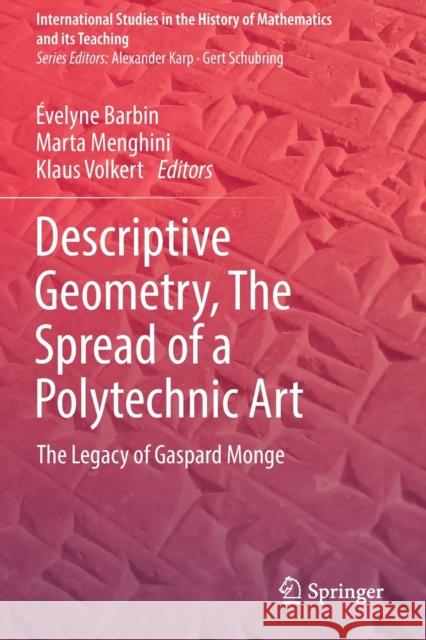Descriptive Geometry, the Spread of a Polytechnic Art: The Legacy of Gaspard Monge » książka



Descriptive Geometry, the Spread of a Polytechnic Art: The Legacy of Gaspard Monge
ISBN-13: 9783030148102 / Angielski / Miękka / 2020 / 437 str.
Descriptive Geometry, the Spread of a Polytechnic Art: The Legacy of Gaspard Monge
ISBN-13: 9783030148102 / Angielski / Miękka / 2020 / 437 str.
(netto: 575,06 VAT: 5%)
Najniższa cena z 30 dni: 539,74
ok. 22 dni roboczych
Dostawa w 2026 r.
Darmowa dostawa!
"I learned much from this book and it caused me to reflect on various aspects of mathematics education in ways I would have not have before. ... I warmly recommend mathematics educators to include Évelyne Barbin, Marta Menghini, and Klaus Volkert's volume on their bookshelves." (Michael N. Fried, Educational Studies in Mathematics, Vol. 106, 2021)
Table of Contents
Part I- First spreading in Western Europe
Chapter 1 Monge’s Descriptive Geometry: his Lessons and the Teachings given by
Lacroix and Hachette
Évelyne Barbin
Chapter 2 Descriptive Geometry in France: Circulation, Transformation, Recognition
(1795- 1905)
Évelyne Barbin
Chapter 3 Descriptive Geometry in Italy in the 19th Century: Spread, Popularization, Teaching
Roberto Scoth
Chapter 4 Luigi Cremona and Wilhelm Fiedler: the Link between Descriptive and Projective Geometry in Technical Instruction
Marta Menghini
Chapter 5 Descriptive Geometry in 19th Century Spain: from Monge to Cirodde
Elena Ausejo
Chapter 6 Descriptive Geometry in Spain and the Emergence of the late Modern European outlook on the Relationship between Pure Science and Technology
Ana Millán Gasca
Chapter 7 Portuguese books of Descriptive Geometry, from University and Polytechnic to Secondary School
Eliana Manuel Pinho, José Carlos Santos, João Pedro Xavier
Part II- Installation of Descriptive Geometry in Europe
Chapter 8 A German Interpreting of Descriptive Geometry and Polytechnic
Nadine Benstein
Chapter 9 The Evolution of Descriptive Geometry in AustriaHellmuth Stachel
Chapter 10 The Vienna School of Descriptive Geometry
Christa Binder
Chapter 11 Otto Wilhelm Fiedler and the Synthesis of Projective and Descriptive Geometry
Klaus Volkert
Chapter 12 At the Crossroads of two Engineering Cultures, or An Unedited Story of the French Polytechnician Charles Potier’s Descriptive Geometry Books in Russia
Irina Gouzevitch and Dmitri Gouzevitch
Chapter 13 Engineering Studies and Secondary Education: Descriptive Geometry in the Netherlands (1820-1960)
Jenneke Krüger
Chapter 14 In Pursuit of Monge’s Ideal: the Introduction of Descriptive Geometry in the Educational Institutions in Greece during the 19th century
Christine Phili
Chapter 15 The Rise and Fall of Descriptive Geometry in Denmark
Jesper Lützen
Chapter 16 Descriptive Geometry at Czech Technical Universities until 1939
Vlasta Moravcová
Chapter 17 The Love Affair with Descriptive Geometry: Its History in Serbia
Katarina Jevtic Novakovic and Snezana Lawrence
Chapter 18 Descriptive geometry in England – Lost in Translation
Snezana Lawrence
Part III- Descriptive geometry in America and AfricaChapter 19 Teaching of Descriptive Geometry in the United States (1817-1915): Circulation among Military Engineers, Scholars and Draftsmen
Thomas Préveraud
Chapter 20 The Teaching of Descriptive Geometry in Egypt (1837–1902)
Pascal Crozet
Chapter 21 The Dissemination of Descriptive Geometry in Latin AmericaGert Schubring, Vinicius Mendes,
Thiago Oliveira and Luiz Carlos Guimarães
Epilogue
Chapter 22 The Myth of the Polytechnic School
Gert Schubring
Evelyne Barbin was previously a professor of epistemology and history of sciences at the University of Nantes (France). Since 2014, she is now professor emeritus at the University of Nantes. She is a member of the Laboratory of Mathematics Jean Leray CNRS UMR 6629, where she is in charge of the research group on history of mathematics. She taught history of mathematics and sciences in all levels of teaching from licence to master. She was the director of 15 theses on the history of mathematics and sciences. Her research concerns three fields: history of mathematics, history of mathematics teachings, and relations between history and teaching of mathematics. The main themes of her historical research are: mathematical proofs in history, mathematics and sciences in the 17th and 19th centuries, and history of mathematics teaching from the 19th to the 20th century. She has worked at the IREM (Institute for Research on Mathematics Education) since 1975. As convenor of the National Committee of the IREM “Epistemology and History of Mathematics”, she has organized 20 national colloquia, 8 interdisciplinary Summer Universities on history and teaching mathematics, and the first European Summer University (ESU) "Epistemology and History in Mathematics Education" in 1993. She was chair of seven ESUs from 1996 to 2014. Since 1980, she has also been a member of the International Study Group on the Relations between History and Pedagogy of Mathematics (HPM). She was the chair of HPM from 2008 to 2012.
Klaus Volkert is a full professor at the University of Wuppertal; he lectures on mathematics, didactics, and history. His interests are mainly in the history of geometry and topology, and recently he started a project on Wilhelm Fiedler. He is Editor in Chief of the journal “Mathematische Semesterberichte” (together with J. Steuding) and editor of the series “Mathematik im Kontext” (with David Rowe).
This book seeks to explore the history of descriptive geometry in relation to its circulation in the 19th century, which had been favoured by the transfers of the model of the École Polytechnique to other countries. The book also covers the diffusion of its teaching from higher instruction to technical and secondary teaching. In relation to that, there is analysis of the role of the institution – similar but definitely not identical in the different countries – in the field under consideration. The book contains chapters focused on different countries, areas, and institutions, written by specialists of the history of the field. Insights on descriptive geometry are provided in the context of the mathematical aspect, the aspect of teaching in particular to non-mathematicians, and the institutions themselves.
1997-2025 DolnySlask.com Agencja Internetowa
KrainaKsiazek.PL - Księgarnia Internetowa









